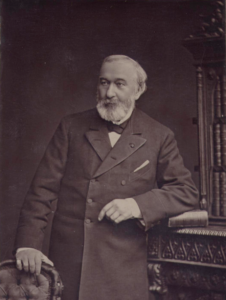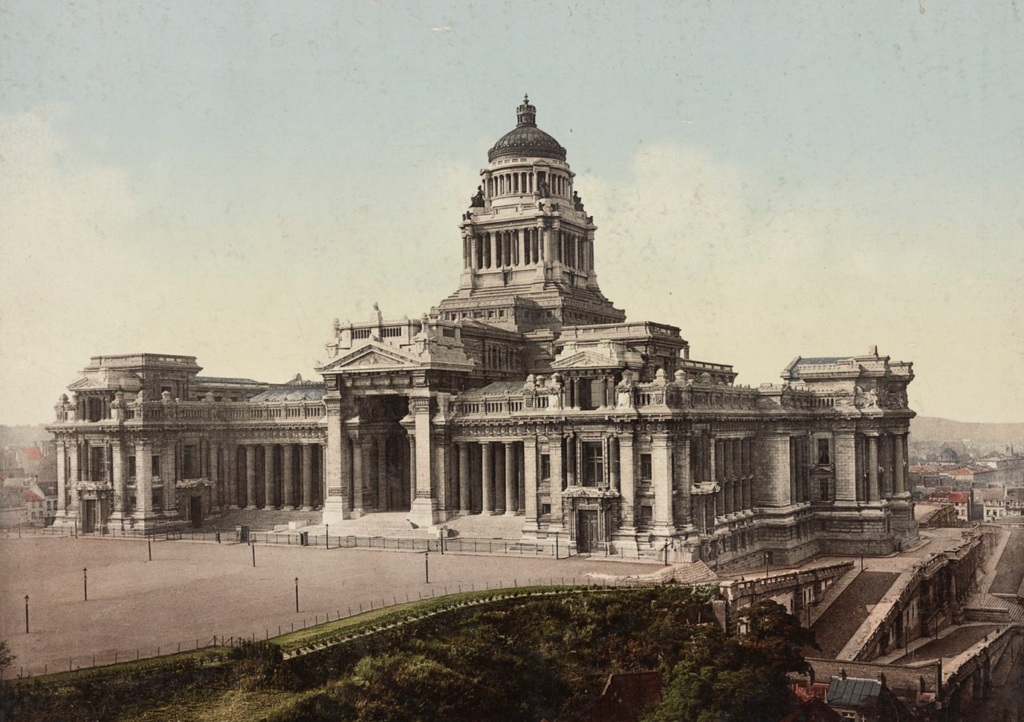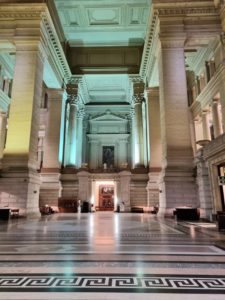The Brussels Palace of Justice © Wikicommons/Martin Mycielski
“If something is serious, it must be old. If it is old… it must be serious”.
With these words, Jef van Hout began his guided tour, during which he introduced me to one of Brussels’ most important buildings, the Palace of Justice
The Korei guide – Korei Guided Tours has been shedding light on Brussels architecture, urbanism, visual arts and history for more than 20 years with guided tours, walking tours and unique interior visits – is very fond of the building and speaks passionately about its history and present. And this building really deserves it, because it is impressive from the very first step.
The Palace of Justice is located on Place Poelaert in the Marolles/Marollen district in the southern part of Brussels.
This building, which was the largest in the world at the time of its construction and remains the largest courthouse in the world today, has captivated many, but has also caused much controversy. Its history begins in the 1800s. The idea of building a large palace of justice arose during the time of the first King of the Belgians, Leopold I.

On the initiative of the Minister of Justice Victor Tesch, an international architectural competition was therefore announced in March 1860. After several failed proposals, the Brussels chief architect of the time, Joseph Poelaert, was commissioned in 1861 to draw up the designs for the new building. He was probably chosen because of his reputation, as he had already designed some wonderful buildings in the city, such as St Catherine’s Church, and coordinated the restoration of the Royal Theatre La Monnaie.
In April 1862, Joseph Poelaert submitted a first design for the building, which was approved. Together with a team of architects including Charles Laisné and Édouard Corroyer, he then undertook the final work.
The project was intended to be grand and impressive, and so Poelaert originally chose a classical Greco-Roman style, but with many influences from other styles. The end result is an eclectic style, original and unique.
However, from the first plans to the final form, the building underwent numerous changes, made by the chief architect himself, as he wanted a monumental building and a reference throughout the world. This is one of the reasons why the construction site almost doubled in size from start to finish and also why the total construction costs of the building were completely underestimated in the beginning. The final figures (today around 450 million euros) were more than ten times higher than the original estimates. This inevitably led to fierce discontent and protests at the time.

Another important reason for the general dissatisfaction with this impressive building was the fact that an entire city quarter was razed to the ground to make room for it. More than 600 houses were demolished and the residents were forced to move to other parts of the city, sometimes to much smaller and cramped dwellings. The building site for the Palace of Justice was not chosen at random, however. The impressive building is located on the top of a hill from which there is a breathtaking view of the city and which gives the impression that justice is above all else. It is also symbolically located on one of three hills, as Mr Van Hout suggests, one for Justice, one for the Royal Palace and one for the Parliament building, representing the three main pillars of the Belgian state.
Built on the ‘Mont des Potences’ (Gallows Hill), where convicts were executed in the Middle Ages and where, according to legend, in the 16th century the famous physician Vesalius stole corpses at night to study the human body, the building was destined to become a symbol and impress everyone who enters it.
The architect himself lived nearby, so perhaps it wouldn’t be fair to accuse him of not caring about the fate of the neighbourhood he destroyed to complete his work.
Construction officially began on 31 October 1866 under the direct supervision of the engineer François Wellens, who was Inspector General of the Ministry of Public Works and President of the Royal Monuments Commission between 1865 and 1897.

Unfortunately, Poelaert didn’t live to see the completion of his masterpiece, nor did the king who’d begun the project. After Poelaert’s death on 3 November 1879, the building was taken over by the architect Joseph Joachim Benoît.
The building was inaugurated personally by King Leopold II in October 1883 after 17 years of hard work.
With a floor area of 26,006 square metres and 250 rooms, it was the largest building constructed in the 19th century and is still one of the largest of its kind. By comparison, it is larger than St Peter’s Basilica in Rome. This monument has left no one indifferent, even though it has sometimes been revered or ridiculed. Joseph Poelaert’s project is colossal and aims to summarise the history of all mankind in the architecture of a single building.
It is impossible not to be impressed by its size and massive columns, reminiscent of an Assyrian royal palace. The entire façade is full of symbols with ancient connotations that reinforce the thought mentioned by the guide at the beginning: “It must be serious and old”. Hundreds of Belgian lions made of stone can be found all over the palace, scales engraved on the walls (symbolising justice), coats of arms on the entrance doors, the sign of Medusa (a symbol meant to protect against and ward off the negative), feathers and snakes (evil), the triangle of the Freemasons (Poelaert was the leader of the Belgian Freemasons at the time), dozens of statues of former jurists, Belgian ministers of justice, but also great orators and legislators of antiquity such as Demosthenes, Lycurgus or Cicero.

The sight is impressive. After climbing exactly 21 steps (symbolic of ‘adult age’), as you enter the building you discover long, marble-lined corridors where you can still hear the hurried footsteps of the hundreds of lawyers and judges who have passed through here and still do every day. Although it is so high, it only has two floors, but the most important and impressive area in the entire building is the “Salle des Pas Perdus” (Hall of Lost Steps), a huge room 80 metres long, 50 metres wide and 80 metres high, located under the dome.
The materials used in the construction were a rich assortment of stone and marble, mostly of Belgian and French origin. Inside, steel structures (including iron floor and roof beams) support the heavy stone masses, themselves a revolutionary work of art. This is somehow understandable, considering that Belgium was one of the largest steel producers in the world in 1866 (and the third greatest economic power between 1865 and 1914).

Because of its grandeur, the Palace of Justice was the inspiration for another beautiful building. The Palace of Justice in Lima, Peru (Palacio de Justicia) was built between 1929 and 1939 as an imitation of the Palace of Justice in Brussels. This attempt at reproduction by the Polish architect Bruno Paprowsky is smaller, the interior is more cramped and it does not have the gilded dome of the Brussels palace.
The original Palace of Justice in Brussels is 186 metres long, 177 metres wide, 116 metres high and has a circumference of about 950 metres. Two large doors, each weighing 10,000 kg, guard the main entrance. As they are made of bronze, they were melted down during the First World War, when the precious metal was used to make cannons needed at the front. After the war, they were rebuilt in their original form.

In fact, three times in history the entire building was damaged and catastrophically destroyed, and three times it was rebuilt in all its glory. The last time, however, it was badly damaged at the end of the World War II, on 3 September 1944. The burning of the Palace of Justice remains one of the key moments in the final liberation of Brussels. During the war, in the rush of the last days before Brussels’ liberation by the Allies, positioned machine guns inside the palace on 1 September, targeting Poelaert Square.
By 3 September, more than half of the German soldiers had left the area, but the few remaining hundred were preparing to blow up the building in a desperate attempt to destroy any incriminating documents and technical equipment inside. So explosives were placed outside and in the basements. The explosion was heard at around 5.00 p.m. and caused considerable damage to the entire structure. The dome crumbled, the walls collapsed and the furniture and decorations burnt.
Reconstruction began immediately after the war, and the palace was even built 2.5 metres higher than the original. By 1948, most of the building was remarkably well repaired. Life resumed its course. But it seems that despite its immense symbolic, cultural and practical value, the building was not properly managed for decades. Its former innovative iron framework was not preserved, and water penetration caused the iron to rust, increasing its volume and cracking the stone masonry. Mould began to multiply dangerously in the corners of the courtrooms.

In some cases, parts of the ceiling even collapsed, causing widely reported injuries. In 2017, one hall had to be closed after part of the floor collapsed. Loose stones, falling ceilings, collapsing floors and mould infestation are actually nothing new for the court staff in the building anymore. Due to the considerable size of the building and the fact that it has an enormous number of windows (every room has plenty of daylight), there is a constant indoor temperature of 15 to 16 degrees Celsius in the old walls. The guide explains that this is quite pleasant in summer, but in winter the cold is unbearable, so many of the courts that once worked in this building gradually moved to other buildings, some even to neighbouring ones. Many areas of the building are now empty (almost 80% of the entire building), and only 45 courtrooms are still in use. One of the most impressive halls you can visit is the Court of Cassation, the highest court in Belgium. It is an impressive hall, decorated with black marble and large paintings on the walls. The overall atmosphere and design convey the feeling of seriousness and weight of the decisions made here.
The building needs constant support and renovation, and in the 1980s it became clear that it was time to do so. To protect pedestrians from the falling plaster of the façade, scaffolding was erected in 1984 when the extensive renovation work was due to begin. Almost four decades later, the scaffolding is still there, but it has since rusted and become unsafe for the project to continue, so that renovation of the scaffolding itself is now necessary. Perhaps this is the reason for the many jokes that are made about it:
“Where do you find the Palace of Scaffolding ? Only in Brussels…”, “The motto of the Palace of Justice: do not judge a book by its cover” or “What crime has the Palace of Justice committed? Why is it behind bars?”

The Palace of Justice has been on the provisional World Heritage List of UNESCO since 2008. It has also been protected by the World Monuments Fund (an independent organisation based in the USA that works to protect the world’s most precious places) since 2016. It was also included in 2016 in the programme ‘The 7 Most Endangered’ of ‘Patrimoine Culturel Immobilier’, a Belgian heritage protection organisation working together with the Poelaert Foundation, founded in 2011 by the Dutch and French-speaking bar associations of Brussels.

In February 2016, the Belgian Ministry of the Interior announced a ten-year plan to restore the palace and bring all Belgian courts back into the building
In 2018, after part of the ceiling collapsed, Jean de Codt, President of the Court of Cassation and the country’s highest judge, spoke publicly about the situation and openly called for additional funding to ensure the sustainability of the building and the safety of those working in it.
The Belgian Chamber of Deputies has reviewed the building’s strange case several times. The Palace of Justice is officially the property of the Belgian federal state and is managed by the ‘Régie des Bâtiments’. A formal request was made for an official statement on the current state of the building, and the status of the renovation work, but as of the publication of this article, there has been no reply.
The project, which is expected to cost more than 100 million euros, is not scheduled for completion before 2030 when Belgium celebrates 200 years since declaring its independence. We all hope that one day in the not-too-distant future, we will be able to see this magnificent building in all its glory.
But that takes time.

